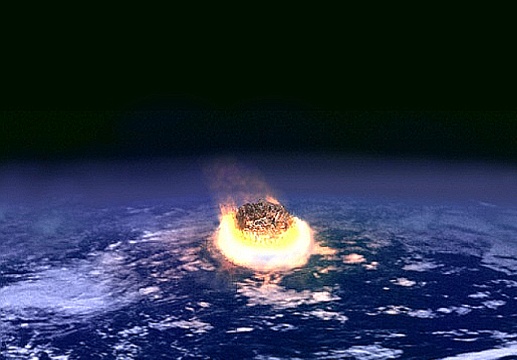In recent posts I talked about asteroids in the context of exploratory probes, mineral resources and international property rights. Today, I want to talk about the threat to Earth of asteroid strikes and some possible ways of diverting approaching asteroids. The Earth was originally formed from many collisions of smaller bodies in the primordial solar disk. The lunar surface displays the many asteroid impacts that is has suffered. There are also impact craters on the Earth but geological, meteorological and biological processes have eroded most of the craters on land. There is strong evidence that a huge asteroid hit the Earth and wiped out the dinosaurs six hundred and sixty millions of years ago. There have been many novels, movies, TV shows about an asteroid strike.
It is estimated that there are around one thousand Near Earth Objects or asteroids more than a kilometer across whose orbits cross the orbit of the Earth. NASA has been working on tracking as many of these asteroids as possible. Even an asteroid smaller than a kilometer could cause enormous damage depending on where it fell. Huge explosions, earthquakes, tidal waves, massive forest fires, titanic storms, volcanoes and atmospheric shock waves are some of the damage that an asteroid strike could cause. A big enough asteroid could extinguish most of the life on Earth. It is not just a question of whether we will be hit but a matter of when. So the big question is whether or not we could do anything about it if we discovered that an asteroid was on a collision course with the Earth.
One possible way of changing the trajectory of an asteroid would be to paint part of the surface white or black. Changing the light reflecting properties of an asteroid would trigger the Yarkovsky Effect. This effect has to do with how uneven thermal distribution could change the force vectors on a rotating body. If this was done early enough, even a minute Yarkovsky Effect could slowly change the path of an asteroid enough so that it would miss the Earth.
If a nuclear device of sufficient size could be sent to intercept an incoming asteroid, its detonation on the surface could alter the course of the asteroid. One possible problem with this technique is the fact that some asteroids are more like a pile of rocks and gravel than one big rock. In that case, the nuclear device would have to be detonated in front of the asteroid.
If a massive object impacted an asteroid at the proper angle, it might be able to change the path of the asteroid. The object could be a huge spacecraft or even another asteroid that had its trajectory altered to impact the asteroid bound for Earth.
If a huge spacecraft could be sent to rendezvous with an incoming asteroid, the two objects would gravitationally attract each other. If the spacecraft engine acted against the gravitational attraction of the asteroid, the asteroid would slowly change its trajectory.
Artist's concept of an asteroid impact:
